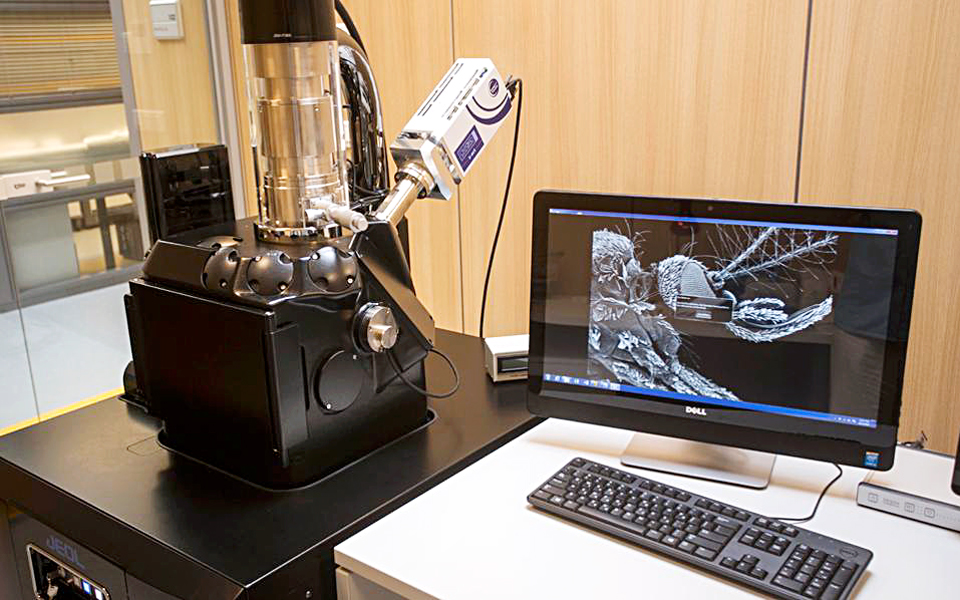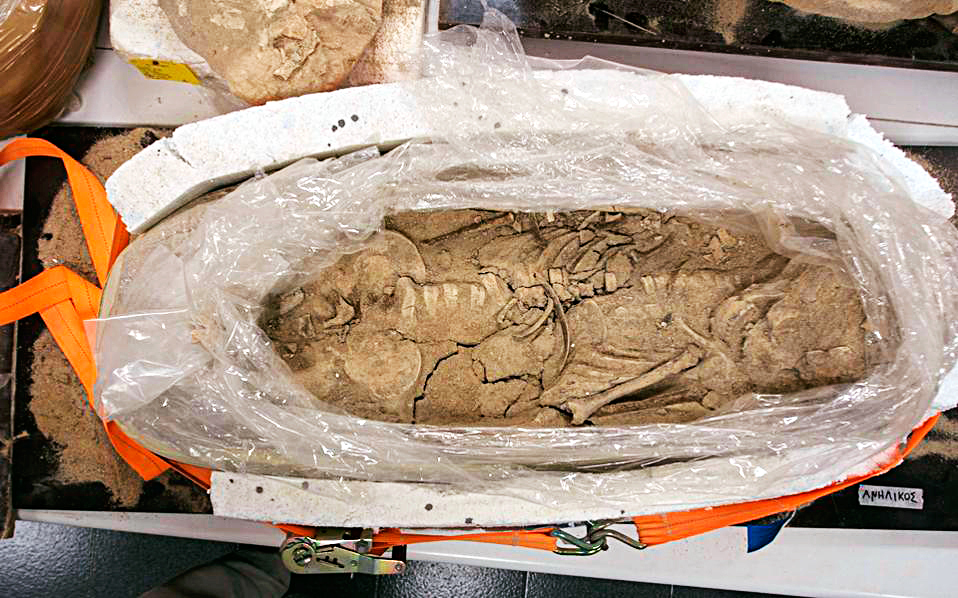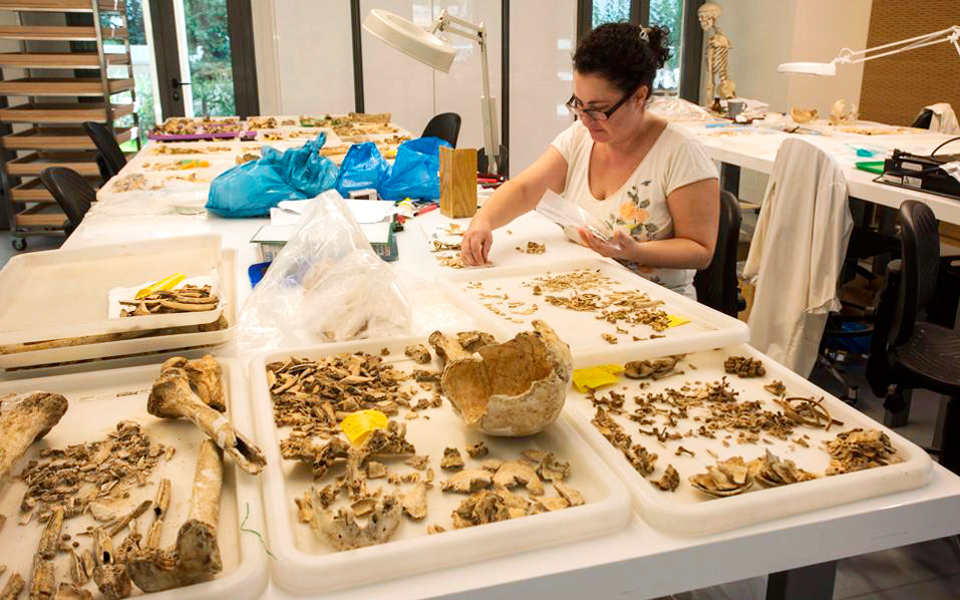When Amphipolis Was in Color
Reconstructing the lost polychromy and meaning…

Details from a mosquito enlarged with a new electronic microscope at the Wienner Laboratory of the American School of Classical Studies in Athens
When the mass grave of Faliro was discovered, it caused quite a stir in archaeological circles. Now, a special team, which you could call the CSI of archaeology, is applying both archaeological and forensic methods to delve into the mystery behind the skeletons.
At the new Malcolm H. Wiener Laboratory at the American School of Classical Studies where the hundreds of finds from the ancient cemetery are housed, a team is preparing to examine the unusual skeletons under the microscope.
“This is the largest, most important of our projects,” notes Panagiotis Karkanias, the laboratory director and geoarchaeologist, while showing us the new spaces created with the donation of the philhellene Malcolm H. Wiener.
The two-storey building was inaugurated a few months ago and is furnished with seven well-equipped laboratories, designed for the applied science of archaeology, bioarchaeology, zooarchaeology, geoarchaeology, paleobotany etc. “We are studying primarily what is not visible to the naked eye,” says Karkanias.

The new Malcolm H. Wiener Laboratory of the American School of Classical Studies
The work of the “archaeological CSI” starts when research needs to shift to the microcosm. In the laboratory basement, a researcher examines the marks on what to everyone else would just look like a stone. “He’s looking at markings on a stone tool in order to understand what it was used for,” explains Karkanias. “Was it for the treatment of the hides, to cut meat, wood or something else?” he asks.
The ancient tool, as well as other finds, will later be put under the laboratory’s powerful microscopes. As for the organic finds, scientists can carry out a direct analysis of their chemical composition, using electron microscopy and x-ray imaging.
In the workshop, ancient plant matter and soil from the archaeological sites are studied to create a mosaic of the ancient environment.
“At Faliro, we will also study the diachronic change of the cemetery’s environment, and learn why they chose that place and why they later abandoned it.If we understand the change of environment, archaeologists will be able to date the burials. The soil has a lot of microfossils that are indicative of the environment, and yields micro fragments of debris which tells us what the people there did,” Karkanias adds.

Skeletons and other findings from the ancient burial ground of Faliro cover almost every surface of the old laboratory
“I believe there are huge opportunities to understand the people of that turbulent period in ancient Athenian history. History is usually written by and for the elite, and we have relatively few archival sources for the archaic period compared to the later years of ancient Athens. The other big cemetery, Kerameikos, was excavated a decade ago and revealed elaborate tombs not seen in Faliro,” insists Professor Jane Buikstra, the famous American archaeologist and creator of the bioarchaeology field of studies.
Buikstra was employed by the Wiener Laboratory as chief of bioarchaeological research and is expected to provide answers for the life of the people of the Archaic period.
Scientists can also detect DNA traces of pathogens and determine if the deaths of children were due to disease.
Those who died, violently perhaps, were foreigners or locals, who met their ends because of political or legal issues. The approximately 350 child tombs provide us with an opportunity to learn about the lives of infants, children and minors.

One of the team carefully sorts through some of the findings from the sites
“Generally, we can assess the health of the Faliro skeletons, the diseases from which they suffered and their life expectancy. They lived a hard life and I’d like them to have a happy ending, for them to be valued and to tell their story,” says Dr. Eleanna Prevedorou, the assistant of Buikstra.
“Here is a mass grave in which their hands are shackled behind their back. This is an unusual grave for Greece, and the way they were buried is charged with negative connotations. In other cultures too, it’s a sign of devaluation, torture or punishment,” she explains.
The operation of the Faliron cemetery is dated between 750 BC until 480 BC, a time period of intense social and political turmoil. Official excavations of the area have been conducted since 1911, while the first of these unusual burials came to light a few years later.
The excavations which started in 2012, under the Ephorate of Antiquities for western Attica during construction works for the Stavros Niarchos Foundation Cultural Center, revealed hundreds of new sites and more evidence of violent deaths at a cemetery that seems to have been intended for people of lower social classes.
The material from those excavations was transferred to the American School’s laboratory, and the plan is to do the same with the skeletons of 80 prisoners discovered in 2016.
A temporary shelter is being planned for the excavation site to protect the finds, which could help narrate the story of a troubled time in Athenian democracy.
In any case, the Faliro skeletons and the remaining graves will find their place in history.
Reconstructing the lost polychromy and meaning…
A nationwide survey highlights improved services,…
Four mysterious Bronze Age artifacts from…
The removal marks a rare moment…